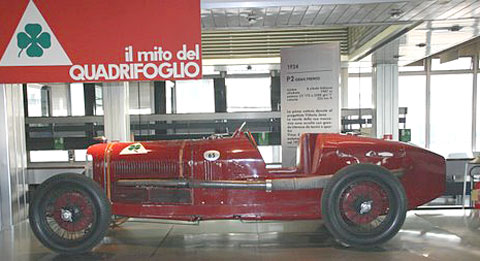
Italian journalist Roberto Motta photographed the P2 on display at the Alfa Romeo Museum for this article.
The Great Ancestor Part I
Alfa Romeo P2, 1923-1924
History by Nicholas Lancaster
Who is Nicholas Lancaster? Author of a new history of Brooklands for Shire Books, Nicholas Lancaster (UK) has been interested in motor racing history since the age of twelve. Recently he has contributed several articles on Alfa Romeo history to the AROC (UK) Magazine and has written two articles on Alfas for VeloceToday in the past.
Color Photography by Roberto Motta
Prior to 1924 Alfa Romeo had made two attempts at entering Grand Prix racing, but both had proved abortive. In 1914 a car was built for the Grand Prix of France but wasn’t ready in time for the race at Lyons. In 1923 a second attempt, with a car designed by Giuseppe Merosi, was thwarted by the death of test driver Ugo Sivocci in practice for the Italian Grand Prix at Monza.
Despite these setbacks, the Alfa Romeo management still harboured serious ambitions in Grand Prix racing and were well aware that in the early 1920s Fiat set the standards. Meanwhile the British Sunbeam team had taken a short cut to success and enticed Fiat designer Vicenzo Bertarione to join them in Wolverhampton. Sunbeam won the 1923 French Grand Prix with a virtual copy of the 1922 Fiat 804, after the new 8 cylinder Fiats had retired with supercharger problems.
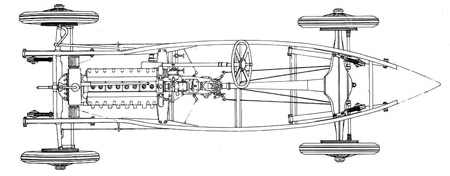
Note the rear springs within the chassis and angled toward the rear.
The Alfa Romeo management learnt from Sunbeam’s success and persuaded former Fiat engineer, Luigi Bazzi, to move from Turin to Milan. Bazzi suggested that Alfa Romeo should approach Vittorio Jano, a talented young engineer who was running the Fiat Grand Prix team.
Enzo Ferrari was sent to Turin in September to offer Jano the post of Chief Engineer. He was backed up by Odoardo Fucito, the company Vice President, who visited Jano shortly afterwards. The engineer duly accepted the Alfa Romeo offer and began work on the next Alfa Romeo Grand Prix car almost at once.
The new car followed Fiat design principles, but Jano incorporated several modifications to deal with weaknesses in the Fiat design. The engine was a straight eight of 1987cc, fabricated from four blocks of welded steel cylinders, whereas the Fiat cylinders were welded in blocks of four and given to thermal distortion. Each was detachable from the alloy crankcase and had its own water jacket. The cylinders had two valves operated from twin overhead camshafts driven via spur gears from a vertical shaft at the rear of the engine. Jano also paid a lot of attention to improving the strength of the valve springs, a weakness on the Fiat designs. Alloy pistons were used.

Fresh from Fiat, Jano couldn’t help but bring along the designs he had created for the firm from Turin. Fiat’s loss, Alfa’s gain.
Although the supercharger followed the Fiat principle and blew air through the carburetor into the engine, the Fiat’s supercharger was attached to the crankshaft and turned at the same speed. Jano geared the P2’s blower off the crankshaft, turning the rotors at 1.235 crankshaft speed for a pressure of 10.5 pounds. Initially a single Memini carburettor was employed, the power being quoted as 134bhp at 5200rpm. According to the factory records further development would increase power to 155bhp at 5500rpm during 1925.
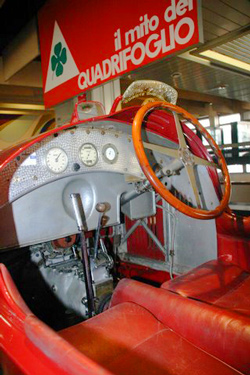
A fairly complete and spacious
cockpit with four speed box
plus reverse.
The gearbox had four speeds plus reverse and was integral with the engine. The chassis was a twin rail type, with semi-elliptic springs all round. The rear suspension was unusual, the springs being mounted within the chassis rails and angled towards each other to follow the taper of the chassis.
The two-seater bodywork- riding mechanics were still carried in 1924- had a bullnose and a tapering tail very similar to the Fiat design, complete with full undershielding. Dry weight was 15cwt, the wheelbase 8′ 8″, with a front track of 4′ 3″ and the rear track much narrower at 3′ 11″.
The first engine was bench tested in March 1924 and the first car completed in early June; in all six were produced. After initial tests at Monza the car was run over the Parma-Poggio de Berceto road course by team drivers Giuseppe Campari and Antonio Ascari.
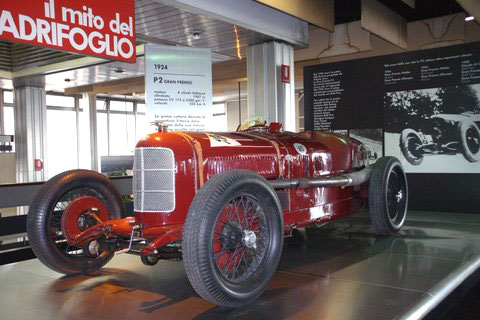
This is the father of the modern Alfa Romeo. The P2 was a remarkable success for the firm and set the stage for the rest of the century in both racing and engineering.
All proved satisfactory and Ascari, accompanied by Bazzi, debuted the P2 on June 9th in the Circuit of Cremona. They had a successful outing, winning easily, and were timed at 121.8mph over the 10 kilometre straight. The next outing, at Pescara, was less successful. The P2 — driven this time by Campari — had tire problems, and failed to finish the race. However the engineers were satisfied with the car’s performance and in August the team traveled to France for the European Grand Prix. The circuit covered fourteen miles of public roads to the south of Lyons. In practice the P2s went well, but most pundits reckoned that the race lay between the Fiats and the Sunbeams. Alfa Romeo entered four cars for Campari, Ascari, Enzo Ferrari and the French veteran, Louis Wagner, but Ferrari fell ill during practice and was forced to withdraw.
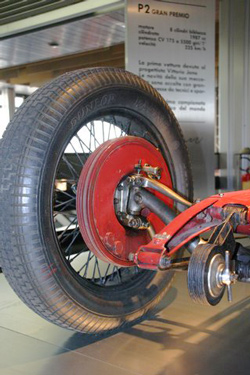
Brakes were big but operated by
cable and rods, which were actually
fairly effective in their day.
At the start, Segrave’s Sunbeam took the lead from Ascari’s P2, but soon faltered with magneto problems. Bordino’s Fiat 805 now went ahead, but Ascari was still running strongly in second place. By lap 17, pit stops had promoted the second Sunbeam of Kenelm Lee Guinness to the front but he retired soon afterwards, allowing Ascari into the lead from Campari and the two Delages of Albert Divo and Robert Benoist. But with three laps left to run, Ascari made for his pit. The cylinder block was cracked and despite his mechanic making desperate attempts to push start the car, Ascari’s race was over.
Now Campari moved into the lead, which he held to the end, winning by just over a minute from Divo. Benoist finished third, with Wagner’s Alfa following home in fourth. The race had lasted for just over seven hours and Campari had averaged 71mph. It was a sensational debut that made the Milanese manufacturer famous throughout Europe overnight.
For the Grand Prix of Italy at Monza, both Sunbeam and Delage failed to enter and Fiat withdrew their team at the last minute. The main opposition came from Mercedes, with a new supercharged straight eight engined car. The P2’s engine had gained a second Memini carburetor, boosting power to 145bhp but also increasing the fuel consumption. A reserve petrol tank was now fitted in the scuttle, displacing the oil tank, which was fitted beneath the mechanic’s seat
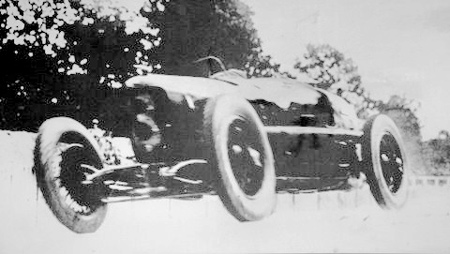
Ascari at Lyon, August 3rd 1924. He led before the block cracked; Campari’s Alfa won.
Unfortunately a fatal accident to Count Zborowski lead to the Mercedes team withdrawing mid-race. Ascari made up for his disappointment at Lyons, and took a hollow victory from Wagner, with Campari in third almost three quarters of an hour in front of the fourth placed finisher.
It was too soon to tell how 1925 would turn out,
but obviously the new Jano designed P2 was going to be a winner.
Excellent job!
The P2 was the first great Alfa GP car. It won the worl’s championship in 1924. In 1925, for some reason, the back end was modified, and they ran a spare tire at the rear.
In 1930, a car ran in the Targa Florio with a slot cut down the cars centerline at the rear.
The P2 ran in 1924 without a spare or with a spare strapped to the side, just in front of the cockpit. In 1925, the point of the tail was chopped off, and the spare was strapped to the rear of the car. In 1930, a P2 ran in the Targa Florio with a slot in the rear cut along the car’s centerline, and the spare rode in that slot.
The P2 won the World’s GP Championship in 1924..
Regarding the tail treatment/spare wheels… Well, yes and no Stuart,. It’s a little more complicated than that, but more will be revealed in Part 2.
Apart from that I hope that you are enjoying the story.
Super! Looking forward to Part 2.
Terrific article. Can’t wait for Part II. Please don’t keep us waiting like Crane!
I have seen a series of photographs of three P2 cars being unloaded of the rail cars in England in 1925. Their appears to be no record of these cars competing in the UK and I wonder if they came to the Uk as publicity for the sales office established in London in 1925 by the Factory?
Interesting – I have no recollection of seeing those photographs and wonder where they were published? I can’t help thinking that sending three cars to the UK for publicity purposes would be unusual.